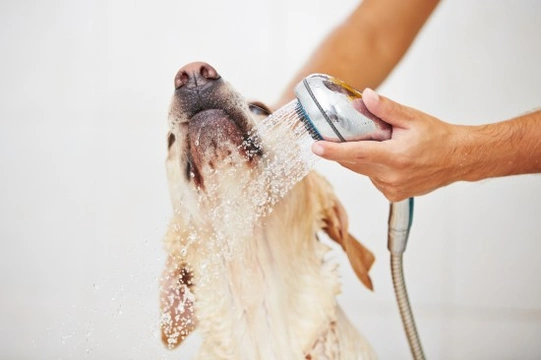
Bathing a dog with atopy
Atopy is a medical predisposition to itchiness of the skin, caused by hypersensitivity or a reaction to a range of potential allergens that do not usually affect other animals of the same species. While atopy is not life threatening and should not shorten your dog’s lifespan, nevertheless, it can be very itchy, uncomfortable and even painful for affected dogs, and will generally cause them discomfort and potentially affect their quality of life.
There is no cure for the condition, as the specific causes of atopic hypersensitivity are not known; contact with one of the triggering allergens is required for an attack to flare up, but it is not always possible to identify exactly what the triggering allergen or allergens are. There may be a genetically inherited component to the condition, but again, this is not clear. Some breeds of dog are significantly more likely to be sensitive to allergens and experience atopic flare-ups; the best known of these is the Shar-pei dog breed, with its wrinkled coat.
In order to manage the condition and keep dogs affected by flare-ups happy and comfortable, generally, regular bathing is recommended in order to remove the source of any allergens and soothe the coat.
If you find that you own an atopic dog and your vet recommends regular bathing in order to take care of them, read on for our tips and advice on how to tackle the condition.
How often to bathe?
Generally, a dog that is prone to atopy or that is going through a flare-up period will require bathing once a week, or possibly even more frequently. When bathing a dog affected by a flare-up, keep the water lukewarm (never cold) rather than hot, as hot water can exacerbate the condition and make itching and associated discomfort more pronounced. Find a temperature that works for your dog, and try to keep it consistent.
What shampoo?
If your vet does not supply or recommend a specific shampoo, use a very gentle hypoallergenic shampoo that will not irritate the skin or make the problem worse. Steer well clear of anything fragranced, coloured or very harsh, as this will make things worse. Your vet might prescribe a special medicated shampoo to help to manage the condition. You may need to leave the shampoo on your dog for up to ten minutes, to allow it to get to work.
Dealing with sore patches
If your dog has distinctive sore patches, hot spots or areas that they have scratched to the point that they are red, inflamed or have broken skin, take special care when bathing your dog, as touching these areas will almost certainly be sensitive or painful for your dog. If you find that even medicated shampoos are too harsh for use on sore areas, use a very weak dilution of a natural baby shampoo until they begin to heal, as this is the gentlest form of bathing for sore skin.
Rinsing and drying
It is vitally important to thoroughly rinse every last trace of shampoo from your dog’s skin, as any traces left behind can both prove drying and ultimately, lead to further sensitivity. When you are sure that your dog is thoroughly rinsed, rinse them once more for luck!
Drying your dog’s coat is also important; pat them dry with a towel first of all to blot off excess water. Never rub them or dry them vigorously, as this will irritate sore skin. Allow your dog to sit somewhere warm in order to dry off, or use a hairdryer on the lowest heat setting with a diffuser in place to gently dry the coat. This may take some time, but it is really important to be thorough, without overly drying the coat!
Applying medications and moisturisers
If you need to apply a moisturiser to your dog’s skin, this is best done when the skin is damp and before you dry them thoroughly. If you also need to apply medication such as hydrocortisone or corticosteroid creams, wait until your dog is completely dry, and leave it at least a couple of hours after bathing in order to allow the skin to settle down and any moisturisers to be absorbed into the skin.
Troubleshooting
While bathing is usually necessary to improve the condition of an atopic dog and is generally a core part of the treatment process, in some rare cases, bathing may make the problem worse. If you find that this is the case, review the shampoos and moisturisers that you use on your dog to see if these are the culprit, or if you are not drying your dog thoroughly enough, or are doing so too vigorously.
If your dog becomes more itchy after bathing, you might find that the shampoo is too harsh for the skin, or is stripping the skin of its natural oils. However, if you do not see any change or improvement in the skin as a result of bathing, you might need to up the frequency of your dog’s baths.



